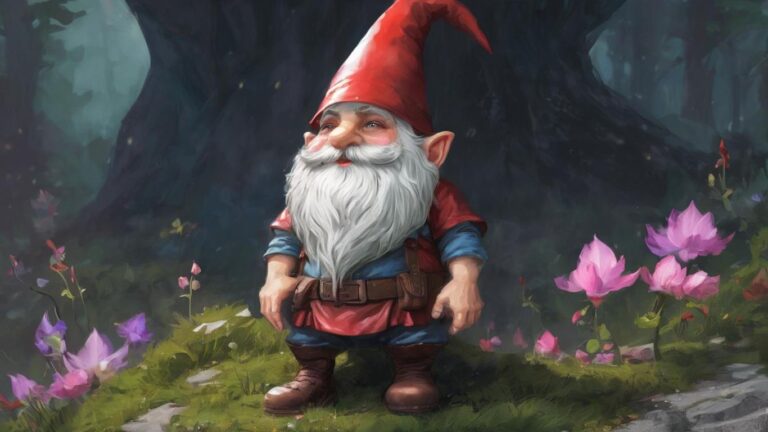Table of Contents
Gnomes have deep roots in European folklore, particularly in Germanic and Renaissance traditions. People consider them mythical creatures—small, humanoid beings often linked to the earth and natural elements. The term “gnome” itself originates from the 16th-century New Latin word “gnomus,” coined by Swiss alchemist Paracelsus.
Folklore suggests that gnomes dwell underground, especially in mines and hidden places beneath the earth. They are believed to be guardians of treasure, possessing an affinity for the earth’s secrets. Gnomes are commonly depicted with beards, pointed hats, and earthy-toned clothing, blending seamlessly with nature.
In various mythologies, gnomes are tied to the spirits of the earth, playing a role in maintaining nature’s balance. Some legends propose that gnomes emerge at night for activities like tending to plants and animals.
While gnomes have a longstanding history in European folklore, they gained widespread popularity in the 19th and 20th centuries as decorative garden ornaments. The concept of garden gnomes—whimsical statues placed in gardens—became prevalent, infusing outdoor spaces with a touch of fantasy.
In modern culture, gnomes appear in literature, art, and popular media, sometimes taking on roles beyond their traditional folklore roots. Despite variations, the core theme of gnomes as earth-dwelling, mystical beings with a profound connection to nature remains consistent in their mythical origin.
Appearance

In the heart of the enchanted forest, gnomes flitted about like shadows. Each gnome stood no taller than a mushroom, their tiny frames draped in vibrant, earth-toned garments. Their skin, the hue of aged bark, blended seamlessly with the wooded surroundings.
Gnarled hats perched atop their heads, adorned with colorful feathers that danced in the breeze. Glinting eyes, like polished acorns, peered out mischievously from beneath the brims. Their faces, etched with laugh lines and wisdom, told tales of countless seasons witnessed.
Beards flowed like cascading waterfalls of moss, adding an air of ancient wisdom. Hands, calloused from years of toiling in the soil, held miniature tools with a craftsman’s precision. The gnomes’ presence was as vital as the roots that crisscrossed beneath the forest floor.
Amidst the ferns and toadstools, they moved with an agility that belied their age. These guardians of the woodland, with pointed shoes tapping lightly on the leaf-littered ground, traversed their realm with a purpose known only to them.
Transitioning seamlessly between sunlight and shadow, the gnomes appeared almost ethereal. Their laughter, tinkling like wind chimes, resonated through the ancient trees. Observing them, one couldn’t help but sense a connection to the natural rhythms of the forest—a living, breathing tapestry woven by these diminutive custodians.
Abilities
Gnomes possessed extraordinary powers, hidden beneath their modest appearance. With a mere touch, they could rejuvenate wilting flowers, breathing life into petals that had lost their luster.
In their presence, the air shimmered with a magical energy, invisible but undeniably palpable. Gnomes harbored an innate ability to communicate with the creatures of the forest, orchestrating a symphony of rustling leaves and melodic bird songs.
Transitioning effortlessly between the visible and unseen realms, gnomes could render themselves invisible to the prying eyes of larger beings. In the blink of an eye, they’d vanish into the dappled shadows, leaving behind nothing but a whisper of their laughter.
Gnomes were also skilled healers, concocting herbal remedies with the precision of alchemists. These elixirs, brewed in secret groves, held the power to mend wounds and cure ailments that plagued the woodland inhabitants.
Their connection to nature extended beyond mere communication; gnomes could influence the elements. With a simple gesture, they could calm a raging storm or coax forth a gentle rain to nurture the parched earth.
Gnomes’ powers weren’t showy but rather subtle, woven into the fabric of the natural world. This symbiotic relationship between the gnomes and their surroundings created an enchanting balance, where every whisper of the wind and rustle of leaves carried the echoes of their mystical capabilities.
Personality

Gnomes, though pint-sized, boast personalities as robust as their magical gardens. Energetic and industrious, they embrace life with zest. Each gnome exhibits a unique flair, be it in fashion or demeanor.
In their tight-knit communities, camaraderie flourishes. Gnomes thrive on social bonds, sharing laughter and tales beneath the moonlit canopy. They cherish tradition but welcome innovation, blending the old and the new seamlessly.
Curiosity propels gnomes to explore the intricacies of nature. With inquisitive minds, they unravel the secrets of the enchanted world. Bold and adventurous, gnomes embark on quests, driven by an insatiable thirst for discovery.
Despite their small stature, gnomes exude resilience. Faced with challenges, they stand tall, united in their determination. Transitioning from joyous festivities to serious endeavors, gnomes seamlessly adapt, their spirits unyielding.
Amidst the mirth and mischief, a deep wisdom pervades gnome society. Elders, like venerable storytellers, pass down ancient knowledge. Gnomes value learning, cultivating a culture where every individual contributes to the collective wisdom.
Popular gnomes
One of the most popular and iconic gnomes in the world is the “Garden Gnome.” Originating from German folklore, these small, whimsical statues became a global phenomenon, adorning gardens and lawns in various cultures. The history of garden gnomes can be traced back to the 19th century when they were first introduced in Germany.
In 1847, a German sculptor named Philip Griebel began producing ceramic gnomes inspired by local myths and legends. These gnomes, initially crafted for ornamental purposes, gained popularity and became associated with good luck. Over time, they spread beyond Germany and gained prominence in other European countries.
The popularity of garden gnomes soared in the 20th century, especially in the United Kingdom. The mass production of these figurines made them accessible to a broader audience. Garden gnomes often feature pointy hats, beards, and distinctive poses, adding a touch of fantasy to outdoor spaces.
The fascination with gnomes extended into popular culture, with gnomes appearing in literature, films, and various forms of art. They are sometimes portrayed as mischievous, magical beings, further contributing to their widespread appeal.
One of the most famous gnomes is “Gnomeo” from the animated film “Gnomeo & Juliet,” which presents a playful and modern take on the classic Shakespearean tale. Additionally, the traveling gnome phenomenon, where people take garden gnomes on trips around the world and document their adventures, has gained popularity in recent years, showcasing the enduring charm of these mythical creatures.
Today, garden gnomes continue to be beloved decorative items, and their popularity persists worldwide. They have become cultural symbols that transcend their mythical origins, bringing a sense of whimsy and folklore to gardens across the globe.





